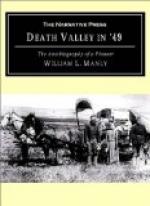Leaving here the road led back from the sea shore and over quite a level table land, covered with a big growth of grass and some timber, and then down to the sandy shore again where the mountain comes so close that we were crowded down to the very water’s edge. Here the never-tiring waves were still following each other to the shore and dashing themselves to pieces with such a noise that I felt awed to silence. What a strange difference in two parts of the earth so little distance from each other! Here was a waste of waters, there was a waste of sands that may some time have been the bottom of just such a dashing, rolling sea as this. And here, between the two, was a fertile region covered with trees, grass and flowers, and watered with brooks of fresh, sweet water. Paradise and Desolation! They surely were not far apart. Here I saw some of the queer things that wash on shore, for we camped close to the beach.
It was a circumstance of great interest to me to see the sun slowly go down into the great ocean. Slowly and steadily it went, getting redder and redder as it went down, then it just touched the distant water and the waves dashed over more and more of its face till all was covered. Were it not for the strong, bright rays that still shot up across the sky one might think it was drowned forever, but in the morning it came up over the mountain top, having apparently made half the circuit of the globe.
Soon after this the road left the shore and turned into the mountains. Another Mission was on this road, Santa Ynez, situated in a beautiful place but apparently in decay, for the men had gone to the mines, leaving the Indians, women, and dogs as in other places. San Luis Obispo was another Mission similarly inhabited, but the surroundings did not seem so pleasant as those we had seen before, although it bore signs that considerable had been done. From here our road bore still more north and we had a long mountain to work over, very rocky, and in some places barren.
San Miguel was a Mission situated on the bank of a dry stream that evidently had seen plenty of water earlier in the season. The surrounding country was covered with scattering timber. Soledad was another place where there were some improvements, located on a small river, but nearly deserted like the other places. Prospects at the gold mines were so favorable that every man felt an irresistible desire to enrich himself, and so they left their families at the Missions and in the towns and rushed off to the mines. Nearly all of them expected to return by winter.
I think I must stop right here and tell about the California carriages of which I had seen several at Los Angeles and at the Missions along our road. The first time I saw one it was a great curiosity, I assure you. The wheels were cut off the end of a sycamore log a little over two feet in diameter and each section about a foot long. The axle was a piece of wood eight inches square with a tongue




